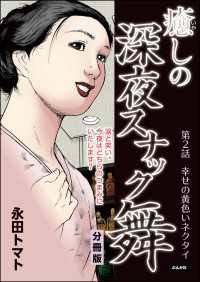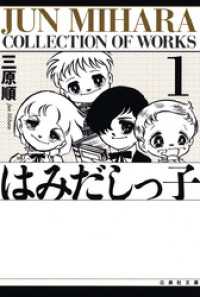- ホーム
- > 洋書
- > 英文書
- > History / World
Full Description
Between 2006 and 2009 Worcestershire Archaeology completed a series of investigations in advance of quarrying at Clifton Quarry, Worcestershire revealing one of the most important sequences of prehistoric to early medieval activity discovered to date from the Central Severn Valley. Well-preserved palaeoenvironmental deposits were recovered from features and associated abandoned channels of the River Severn. Analysis of this evidence is underpinned by a comprehensive programme of scientific dating, providing a record of changing patterns of landuse and activity from the Late Mesolithic onwards. Significant discoveries included a series of Grooved Ware pits and an extensive area of Early to Middle Iron Age activity. One of the Grooved pits was of particular importance as it contained an exceptionally rich material assemblage comprising two whole and four fragmentary polished axes, numerous flint tools and debitage, significant quantities of Durrington Walls and Clacton Style pottery, and abundant charred barley grains and crab apple fragments. The Early to Middle Iron Age activity was notable since unusually for a lowland site it was dominated by in excess of 100 four-post granary structures and 130 pits. The full extent of the activity was not established but it appears unenclosed and it is suggested that this represents the specialised storage zone of a much larger settlement. Phases of activity on the floodplain and terraces adjacent to the river also included a Bronze Age burnt mound with associated pits and a trough, a scatter of Romano-British features and an early medieval timber-lined structure associated with flax retting.
Contents
List of figures
List of tables
Contributors
Project summary
Résumé
Zusammenfassung
Acknowledgements
Part 1: Introduction
Background
Landscape and archaeological context
Aims
Part 2: Methods
Documentary search
Fieldwork methodology
Structural analysis
Scientific dating methodology (Peter Marshall, John Meadows, Christopher Bronk Ramsey, Gordon Cook and Ian Tyers)
Artefact methodology (Emily Edwards, Lucija Šoberl, Richard P. Evershed, Hugo Anderson-Whymark, Robin Jackson, Laura Griffin and Ian Tyers)
Environmental methodology (Katie Head, Nick Daffern, Elizabeth Pearson, Alan Clapham, Steven J. Allen, Steven R. Davis, Shirley Wynne and Anthony Brown)
Part 3: Excavation Results
Geological deposits
Palaeochannel deposits
Late Neolithic
Late Neolithic/Early Bronze Age
Middle Bronze Age
Early to Middle Iron Age
Roman
Early medieval
Natural features
Undated features
Part 4: Artefact Analysis
Middle Neolithic Pottery (Laura Griffin)
Late Neolithic and Beaker pottery (Emily Edwards)
Late Neolithic pottery absorbed residue analysis: (Lucija Šoberl and Richard P. Evershed)
Neolithic and Early Bronze Age: fi red clay (Emily Edwards)
Neolithic and Early Bronze Age flint from the Area 10 watching brief (Hugo Anderson-Whymark)
Flint from the Area 10 excavation (Robin Jackson)
Neolithic and Early Bronze Age worked and burnt stone (Fiona Roe)
The Bronze Age and later ceramic assemblages (Laura Griffin)
Metalwork (Laura Griffin)
Fire cracked stone (Laura Griffin)
Iron Age stone objects (Ruth Shaffrey)
Slag and metalworking residues (Derek Hurst)
Early medieval wooden waterlogged artefacts from timber-lined structure [2121] (Ian Tyers)
Part 5: Environmental Analysis
Pollen (Katie Head and Nick Daffern)
Plant macrofossils from the palaeochannel (Elizabeth Pearson)
Entomological results from the palaeochannel (Steven R. Davis, Shirley Wynne, Anthony Brown)
Plant macrofossils from non-palaeochannel deposits (Alan Clapham)
Charcoal (Alan Clapham)
Waterlogged wood (Alan Clapham)
Part 6: Synthesis and Discussion
Palaeolithic
Mesolithic
Early to Middle Neolithic
Late Neolithic
Bronze Age
Iron Age
Romano-British
Early medieval
Medieval, post-medieval and modern
Conclusions
Appendix 1: Neolithic axes and Grooved Ware (2006). Thin section analysis (Robert A. Ixer)
Appendix 2: Pottery and a loomweight from the 2008/9 excavation. Thin section analysis (Robert A. Ixer)
Bibliography
Index








